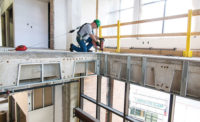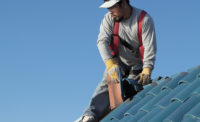OSHA states that "to maintain their service life and high performance, all belts and harnesses should be inspected frequently. Visual inspection before each use should become routine, and also a routine inspection by a competent person."1
Why inspect? Three quick reasons:
1. It’s the law.
2. It ensures the safety of your gear. Your life or livelihood may depend on it.
3. Inspection is a key element of creating a healthy culture of safety. It promotes a proper frame of mind for the user who not only has a job to do but must perform that task with the added risk of working at height.
Two standards relate to personal fall protection equipment pre-use checks. The first is federal law. That’s 29CFR 1926.502(d)21. It requires that all equipment must be inspected by the user before each use.
The second, ANSI standard ANSI Z359.1.6, requires that a competent person other than the user must formally inspect the item at a prescribed interval and after any event that may have compromised its safety. For most industries, the prescribed period is 12 months. In the construction industry, however, the inspections are required every six months [ANSI A10.32].
It’s important to note that equipment cannot be modified or repaired by users. Any item that fails an inspection must immediately be removed from service.
What does this mean? If I’m an authorized person — authorized to wear a harness or use fall protection equipment — each time I am to use the equipment (whether it is my own or community or borrowed equipment), I must inspect it before use.
Competency counts
In addition, according to the ANSI standard, that same equipment must undergo additional inspections by another person — a competent person — during the required time period.
A competent person, by definition, is someone who is capable of identifying existing and predictable hazards in the surroundings or working conditions that are hazardous or dangerous to employees, and who has the authority to take prompt corrective measures to eliminate them. They’re inspecting the equipment not for their own use, but on behalf of someone else. In the training I conduct, I tell my students when they are performing a competent person inspection that the question to ask is: “Would I give this equipment to my son or daughter to wear?” If the answer is “no,” then why would you let one of your workers wear it?
Pre-use inspection
Everyone has their own system. The key is to have a system — and to follow it with each use. There’s a potential, as with any routine, to go too quick and dirty. That’s a recipe to miss something important. My inspection system is a five-step system.
• The first step is hardware. Inspect the metals, rivets, snaps, and dees. Is anything missing? Is there corrosion, especially heavy rust on a steel item where the galvanization is missing? If there is pitting, corrosion, deep indentions, cracks, and so forth — don’t use it. Deformation or bending from a drop or use? Dispose of it. Check components for correct function or loose or stiff parts. Spring-loaded snap hooks must immediately slam shut. Nothing sticks. Examine wear and tear. Only properly functioning components are acceptable.
• Second step: materials, such as webbing, ropes, and the like. We are going to check for wear and abrasion, cuts or frayed or shredded or broken threads. Fading from UV light? These are all weak spots. Chemical damage might discolor some synthetic materials. Is the damage deteriorating the synthetic material or not? That is probably hard to tell, so don’t use it. Weld splatter can burn holes in synthetic fibers. We’ve tested that holes, burned or poked into webbing can affect at least 50 percent of the tensile strength of that webbing.
• The third step is to check the stitching to make sure it’s not damaged. Manufacturers will use a loop stitch. If that stitch breaks, it will actually unravel if there was an event.
• Fourth is labels and tags. Are the labels in place? Are they readable? If not, then ANSI says don’t use the item. ANSI requires that you can read every word on the tag.
• The fifth step is called function and design. A portion of this is personal. It is intuition or “gut instinct.” I mean, take an honest look at the equipment and ask yourself: “Will this function the way it is designed?”
The greatest challenge
The most challenging area seems to involve inspecting the materials. This is understandable. There are several varieties of materials on the market — nylon, polyester, Nomex®, Kevlar®, and blends. They are all different in look, feel, properties, and price. Nylon is the least expensive. It stretches well but does not wear well and is not very chemical resistant. Polyester is a step above in terms of both wear and resistance to chemicals, but does not stretch as much. It looks different, feels different and costs more.
So how does a user know if the material they’re inspecting is good or bad? They look at the condition and they look for flaws. They look for snags, cuts, burns, damaged areas, pinched areas, and the like. It’s a key area for inspection.
Pushbacks and gaps
Where there may be issues is with community gear. This is fall protection equipment that an individual will go to a tool crib or trailer, for instance, and check out to use that day and return that night. A person checking out community gear should say: “This equipment is new to me. It’s the first time I have seen it. Is the size correct? Others have used that gear. Have they used it properly? Does it function correctly? Are the labels and tags in place?”
For community equipment, there may be an additional issue at the company level. Record keeping of inspections and usage may be less accurate. Also, surprisingly, from what I have heard, many companies may not undertake the required annual or six-month competent person inspections. They know of and practice pre-use inspections, but that is all. This is a critical failure. These companies may be first and foremost risking the serious injury or fatality of their employees — as well as a citation if an incident or accident were to happen.
References:
1. Occupational Safety & Health Administration. Fall Protection Information. Inspection and Maintenance. https://www.osha.gov/Region7/fallprotection/fall_protection_info.html


